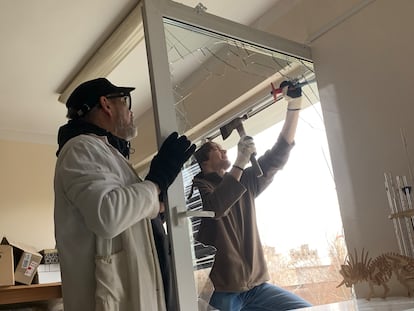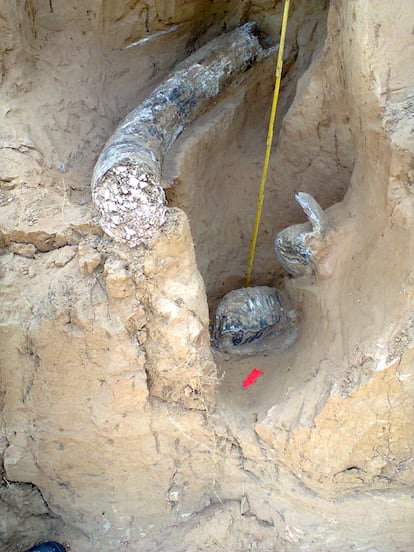The scientist trying to save unique fossils on the Ukrainian front lines
Natalia Gerasimenko was one of the members of the team that uncovered the oldest human artifacts in Europe: stone tools carved by ‘Homo erectus’ 1.4 million years ago in western Ukraine

On New Year’s Eve 2022, Russian air strikes hit the Taras Shevchenko National University of Kyiv, the largest university in Ukraine. The explosions blew out the windows of several buildings, including the laboratory of geologist Natalia Gerasimenko. There were no injuries, but no one could remedy the fact that pollen released by flowers and plants thousands or even millions of years ago was scattered everywhere and lost forever.
“Recent times have been very difficult,” says Gerasimenko, 70, from Kyiv in a teleconference conversation. Neither her perfectly coiffed hair, nor her impeccable yellow sweater, nor her relaxed smile, give the impression she is speaking from a country that has been at war for over two years. “Thanks to Western countries we have the Patriot system in Kyiv and far fewer shells are falling. Even so, air raid alarms are very frequent. Sometimes they go off in the middle of class and students have to run to bomb shelters. It’s not pleasant, but we survive,” she adds.
Raised and educated in the Soviet Union, Gerasimenko decided to become a geologist against the advice of her parents, who were both forestry engineers and saw little future in the profession. In those days it was not possible to travel overseas, but in her early university years her professors were very well connected and she received visits from some of the most significant researchers of the time. Among them was George Kukla, a geologist born in the former Czechoslovakia and who immigrated to the United States and was one of the first scientists to demonstrate that, over the course of the previous millions of years, the Earth and all the creatures that inhabited it lived at the mercy of climatic cycles that every 100,000 years or so covered a large part of Europe and America with impenetrable glaciers. Between cycles, a window of climatic bonanza allowed life to flourish and facilitated the first human migrations.
Pollen is an exceptional marker to investigate these periods. After the 2022 bombing, it was crucial to prevent the volatile sex cells of today’s plants from sneaking into the building and contaminating the few samples that had survived the attack, Gerasimenko explains. Her small victory in this war, and that of her students, is that the lab is now fully shored up and has been back in operation since May.

A few days ago, Gerasimenko was one of the members of the team that uncovered the oldest human artifacts in Europe: stone tools carved by Homo erectus 1.4 million years ago in western Ukraine. Gerasimenko’s work in sediment dating and her reconstruction of past ecosystems was an important contribution to the discovery, which was published in the prestigious journal Nature.
This triumph for Ukrainian science was published almost at the same time as the most detailed report to date on the impact of the war on the country’s scientific system. Economic losses amount to some $1.26 billion, according to the study carried out by the United Nations. Thousands of buildings have been destroyed or damaged and the employees of 18 universities and research centers have been evacuated to the west because they are too close to the front line or have fallen to Russian forces.
This is the case of the Institute of Safety Problems of Nuclear Power Plants, located in Chernobyl, which was occupied by Putin’s troops in March 2022. The entire surveillance system of the Ukrainian nuclear industry, including the Zaporizhzhia power plant, has been occupied or destroyed by the Russians. The loss of this equipment could endanger the health of “more than two billion inhabitants of Europe, North Africa, the Middle East and Central Asia,” the report highlights. According to the paper, 208 members of the Ukrainian National Academy of Sciences enlisted in the military and 11 have died in combat. Overall, 1,518 scientists have volunteered for duty in combat regiments. Around 5,500 Ukrainian researchers have left the country to work in other countries, mainly Germany and Poland.
A few days after the Russian invasion, on February 24, 2022, Gerasimenko fled to the south of the country. She spent a few months there until her university helped her to leave Ukraine. “There was a lot of solidarity. I was invited to universities in Sweden, Poland, Germany, Romania and Italy. Finally, I went to La Sapienza University in Rome. But after a few months it was time to return to my country; especially as my daughter and granddaughter had done so as well.” Her son-in-law, who is 55, could not leave Ukraine under martial law. After the stabilization of the front and a relative return to normality, the university forced the resumption of on-site classes. Anyone who did not want to return to face-to-face work would lose their job, says Gerasimenko, who now teaches undergraduate and graduate classes every day and supervises eight doctoral theses.
“My job is to study the past to understand the present and forecast the future,” says Gerasimenko, an expert in paleogeography and geoarchaeology. “One of the things we see is that all past cultures relied heavily on nature: 7,000 years ago, for example, in the Neolithic, pollen shows us that the climate of the planet became very benign. But about 2,000 years later it got worse and these proto-civilizations disappeared from Ukraine. Thanks to this science we can see all these connections. It is very interesting and important.”

There are many sites in Ukraine that researchers have not been able to return to. Some have been mined and some are too close to the front lines. The one that worries Gerasimenko the most is near Kostiantynivka, in the east of the country, just a few miles from the front lines of Donetsk. Real tragedies have been experienced there, such as the shelling of a market that left 16 people dead. In 2017, paleontologist Alexander Filippov discovered the almost complete skeleton of a mammoth in the vicinity and, in more superficial strata, stone tools made by humans.
It was an exceptional find, as it is possibly a Mammuthus meridionalis that lived between 1.8 million and 700,000 years ago, explains the scientist. The tools are about 500,000 years old. The presence in eastern Ukraine of an animal characteristic of warmer climates than today, and the subsequent appearance of humans, shows that there may have been one of those windows of time in which the huge glaciers retreated and allowed a few millennia of prosperity. This is very similar to what has been seen at Korolevo, the site where the oldest tools in Europe were found. “These bones are extremely valuable, unique in all of eastern Ukraine. They need to be excavated very carefully and following strict paleontological procedures,” which is impossible at the moment, Gerasimenko explains.
Last Friday, the geologist was able to talk to her colleague, archaeologist Yuri Koval, who was working in the area. His entire department has been moved to Lviv and he has been evacuated with his wife and infant child to a safer place. Along with Filippov, Koval has covered the excavation with earth to protect it from bombs, but shells are constantly falling, “sometimes less than 10 meters away.”
If the worst happens, scientists have an ace up their sleeve. “Before covering the site, Koval extracted the mammoth’s teeth and took them to Lviv,” explains Gerasimenko. “They still retain the enamel, making them the best sample for good geochemical dating or even extracting DNA. In fact, before the war started, we were planning to invite international experts to carry out that work.”
Gerasimenko has blind faith that she will one day be able to resume the project. “I am convinced that this war will end with Ukraine’s victory. When? I don’t know. Russia is a monster with lots and lots of resources; but we will win. And I have no intention of retiring. I love my work.”
Sign up for our weekly newsletter to get more English-language news coverage from EL PAÍS USA Edition
Tu suscripción se está usando en otro dispositivo
¿Quieres añadir otro usuario a tu suscripción?
Si continúas leyendo en este dispositivo, no se podrá leer en el otro.
FlechaTu suscripción se está usando en otro dispositivo y solo puedes acceder a EL PAÍS desde un dispositivo a la vez.
Si quieres compartir tu cuenta, cambia tu suscripción a la modalidad Premium, así podrás añadir otro usuario. Cada uno accederá con su propia cuenta de email, lo que os permitirá personalizar vuestra experiencia en EL PAÍS.
¿Tienes una suscripción de empresa? Accede aquí para contratar más cuentas.
En el caso de no saber quién está usando tu cuenta, te recomendamos cambiar tu contraseña aquí.
Si decides continuar compartiendo tu cuenta, este mensaje se mostrará en tu dispositivo y en el de la otra persona que está usando tu cuenta de forma indefinida, afectando a tu experiencia de lectura. Puedes consultar aquí los términos y condiciones de la suscripción digital.
More information
Archived In
Últimas noticias
Mustafa Suleyman: ‘Controlling AI is the challenge of our time’
Venezuela breaks energy agreements with Trinidad and Tobago due to alleged complicity with the US
The murder of Michele and Rob Reiner: A tale of horrific days in Hollywood
Trump orders a ‘complete blockade of sanctioned oil tankers’ going to and from Venezuela
Most viewed
- ‘El Limones’ and the growing union disguise of Mexican organized crime
- Christian Louboutin: ‘Young people don’t want to be like their parents. And if their parents wear sneakers, they’re going to look for something else’
- ‘We are dying’: Cuba sinks into a health crisis amid medicine shortages and misdiagnosis
- A mountaineer, accused of manslaughter for the death of his partner during a climb: He silenced his phone and refused a helicopter rescue
- The low-cost creative revolution: How technology is making art accessible to everyone










































